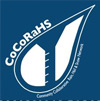
Scientists want you to record and share rain measurements and other on-the-ground observations in part to help pinpoint hurricane Irene’s actions, determine her next steps, and better predict and react to future storms. In addition to your help recording on-the-ground rain precipitation, scientists rely on watershed volunteers to provide important clues about the effects of storm-water runoff, carbon cycles of waterways, etc. Here’s a list of opportunities to get involved in local watershed monitoring efforts. To help scientists record on-the-ground rain measurements, you will need a high capacity rain gauge.
Don’t have a rain gauge? Enter here to win a free one so you can join in next time! Through the Changing Planet series, a partnership with National Science Foundation, NBC Learn, and DISCOVER Magazine, we’re offering up to 20 of these gauges to our members, free of charge ($25 value).
(Note: Safety first. Please heed all evacuation recommendations issued in your area. )
Not able to measure rain? The Philadelphia Inquirer published a list of websites that post data and images where you can watch Irene in real time and learn more about its real-time effects. (See below.)
Measure rainfall, help science:
 |
The Community Collaborative Rain, Hail, and Snow Network (CoCoRaHS) is a volunteer network of backyard weather observers. People of all ages measure and map precipitation (rain, hail and snow) in communities across the United States. The data is used by a wide range of agencies and programs.Volunteers are needed for two programs. |
 |
SKYWARN spotters are essential information sources for the National Weather Service with the responsibility to identify and describe severe local storms. Observations by spotters helps the National Weather Service issue more timely and accurate warnings for tornadoes, severe thunderstorms, and flash floods and thus save lives. |
 |
Not on the east coast? Here’s one for south westerners. Join RainLog‘s network of over 1,000 volunteers that use backyard rain gauges to monitor precipitation across Arizona and in neighboring states. Data collected through this network will be used for a variety of applications, from watershed management activities to drought planning at local, county, and state levels. |
 |
Kids: Tracking Climate in Your Backyard seeks to engage youth in real science through the collection, recording, and understanding of precipitation data in the forms of rain, hail, and snow. |
Here are some websites, originally published by the Philadelphia Inquirer, that post data and images to answer the following questions:
How fast is the nearest stream rising?
A U.S. Geological Survey site logs data from stream gauges. https://pa.water.usgs.gov/
Is there a storm-surge tracking map?
Developing, by the U.S. Geological Survey. http://water.usgs.gov/osw/floods/2011_HIrene/index.html
How hard is it blowing in your neighborhood?
Greg Heavener, National Weather Service meteorologist in Mount Holly, recommends this site, where people with personal stations upload their data. Searchable by zip code.https://www.wunderground.com/
What are Delaware River observations?
Includes data from water-level sensors installed on bridges after past floods. https://www.water.weather.gov
What’s happening offshore?
The National Oceanic and Atmospheric Association logs ocean-buoy data, including wind speed and wave heights. http://www.ndbc.noaa.gov/
Rutgers University is part of the Mid-Atlantic Regional Association Coastal Ocean Observing System, which posts data on satellites and the underwater “gliders.” Has an Irene science blog. http://maracoos.org/
What does Irene look like?
The National Weather Service’s Hurricane Center has the most recent forecasts, including radar images and wind-speed probabilities. http://www.nhc.noaa.gov/
How about from space?
NASA images and video. http://www.nasa.gov/mission_pages/hurricanes/main/index.html
